Garter Snakes of Western Washington
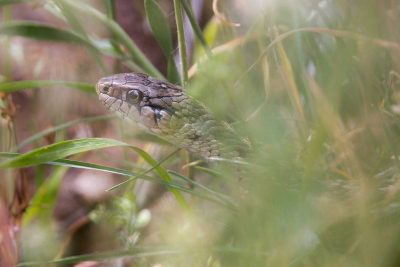
Garter Snakes by Chris Byrd
When most people think about the fauna of the western portion of Washington State snakes are not the first animals to spring to mind. The cool, rainy climate that predominates for the majority of the year makes it difficult for most reptiles to successfully reproduce.
One major exception to the low reptile diversity rule that occurs in the region lies with the garter snakes (Thamnophis spp’s). Within the coastal region from Cape Disappointment to the Canadian border (latitude 49 degrees) three species of garters call it home: The common garter snake (Thamnophis sirtalis), western terrestrial garter snake (Thamnophis elegans) and the northwestern garter snake (Thamnophis ordinoides).
Identification of Garter Snakes
The coloration of these snakes throughout the region can be highly variable, which adds to the confusion of identifying garters to species in the field. As a group the Thamnophis ssp’s are slender snakes with heads that are slightly larger than the body diameter, stripes usually running dorsally and laterally down the length of the body, keeled dorsal scales that lack apical pits, a single anal scale, and paired sub caudal scales.
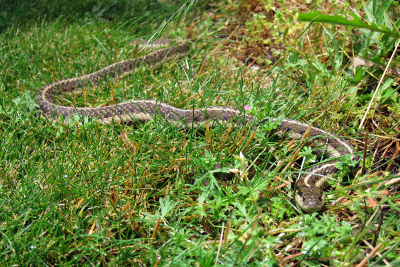
Common Garter Snake (Thamnophis sirtalis):
The common garter snake is the most variable of the Thamnophis species in western WA. Three different sub-species of common garter snake have contiguous ranges in the area - T. s conncinus (SW WA. and outer coast of the Olympic Peninsula), T. s pickeringii (Puget Sound lowlands) and T. s fitchi (east of the Cascade crest). All common garter snake subspecies have seven upper labial scales.
T.s conncinus (red-spotted garter snake) has a solid-colored red or orange head with a wide yellow or green dorsal stripe and no lateral stripes. The sides of the body are black with conspicuous red spots.
T.s pickeringii (Puget Sound garter snake) has a turquoise to yellowish dorsal stripe and lateral stripes of the same color. The sides of the body are black with flecking that is usually the same color as the dorsal and lateral stripes but can occasionally be a red/orange coloration reminiscent of the conncinus and fitchi sub-species.
T.s fitchi (valley garter snake) has a yellow dorsal stripe and similarly colored lateral stripes. The sides of the body and the top of the head are black. The sides of the body between the dorsal and lateral stripes have a series of red blotches. The sides of the jaw are lighter in coloration.
Note: Even with the above mentioned delineation between T. sirtalis sub-species it must be kept in mind that variation can exist, and difficulty can still be found in placing garters down to sub-species in the field.
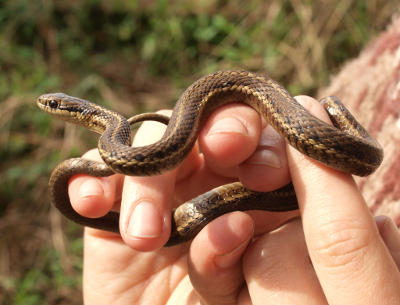
Northwestern Garter Snake (Thamnophis ordinoides):
The northwestern garter snake is another extremely variable garter snake species. The dorsal stripe can be red, yellow, tan, turquoise, greenish, blotched, or absent altogether. The lateral stripes have a similar range of colorations. The color of the sides between the dorsal and lateral stripes can vary from black to brown to shades of gray. The sides usually have a variable amount of black spotting (the black spots do not touch the dorsal stripe) and sometimes light white flecking is present as well. Some individuals show a black stripe behind the eye. Northwesterns have seven upper labial scales.
The northwestern garter snake can be differentiated from T. sirtalis, and T. elegans by its small adult size, small head, and tendency to have small red blotches on the ventral scales. T. ordinoides is also the only Thamnophis species in Western WA that, at times, shows a red dorsal stripe.
Western Terrestrial Garter Snake (Thamnophis elegans):
The only subspecies of the western terrestrial garter snake found in Western Washington is the wandering garter snake T. e vagrans. The wandering garter snake has a narrow dull yellow dorsal stripe most often with black blotches that touch the dorsal stripe giving it a broken appearance. The lateral stripes are dull yellow as well. The overall body coloration is usually gray or tan. Western terrestrials have eight upper labial scales.
Note: Some garters in the Pacific Northwest are melanistic (they develop darker melanin skin pigments - the opposite of albinism).
Sexing: Telling apart male from female garters can be a very difficult task in the field. Overall, like most live-bearing snakes, garter snake females are longer and thicker, while males are shorter and skinnier. Males also tend to have longer and thicker tail. Bear in mind that adult snakes are much easier to sex than juveniles.
Be More Prepared For Your Next Outdoor Adventure!

Don't leave home without knowing these six essential survival skills. Our free survival mini guide reveals the strategies of:
- Shelter & fire to prevent the number one cause of death
- Obtaining clean water to avoid life-threatening dehydration
- Common wild survival foods and other critical skills!

Habitat
Garters are found in wide variety of habitats in Western Washington. The common and western terrestrial are typically found close to water (although they may be found further from water in moist areas).
Northwestern garters are more typically found in terrestrial environments often underneath cover objects.
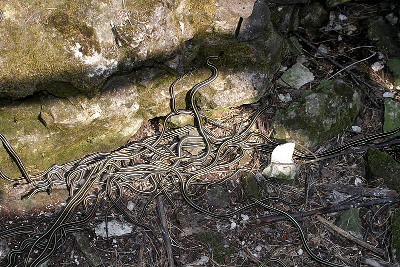
Seasonal Activity
In Western Washington garter snakes are active from late winter (March) until mid-fall (November). During the winter months they hibernate communally in rock piles and other areas of heavy cover that help with overwintering thermoregulation.
Garters are generally only active at air temperatures of 55 degrees or above. Upon emerging from hibernation they spend the late winter/early spring time period near their hibernation sites. Later in the year the snakes will disperse to foraging sites further from the hibernaculum.
Breeding
Garter snakes give live birth, and copulation occurs shortly after emergence from winter hibernation. Male garters emerge first and wait for the emergence of females. More than one male may attempt to mate with a single female resulting in mating “balls” of several males and one female.
Garters give birth in July and August. Females will often congregate in grassy fields presumably to increase body temperature which in turn helps with the development of the embryos. They typically give birth to between 3 and 85 young.
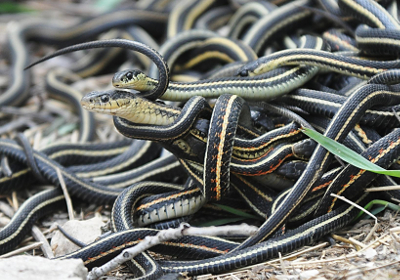
Feeding
Adult common and western terrestrial garters feed primarily on vertebrates with fish and amphibians making up the bulk of the diet. Juveniles of the above mentioned species feed more heavily on invertebrates with slugs, snails and earthworms all being primary parts of the diet.
Northwestern garters feed mostly upon invertebrates with earthworms and slugs making up the majority of the diet in most areas.
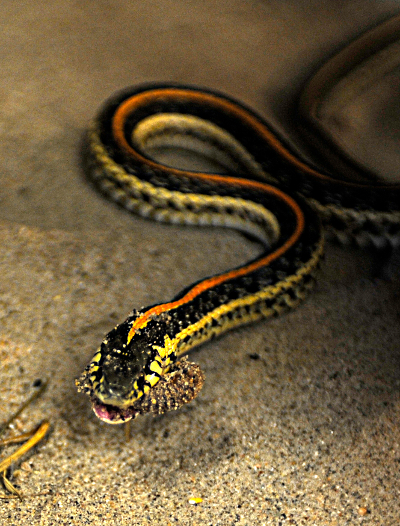
Other Ecological Notes:
• Garter snakes are primarily diurnal.
• Females are larger than males in order to bear more young.
• Females are less active than males.
• Garters use retreat sites at different times throughout the day. Snakes that are digesting a male, gravid, or shedding often spend a very limited amount of time outside of retreat sites.
• When disturbed garters expel a mixture of feces, urine and musk from their cloaca as a predator deterrent.
• Garters are technically venomous delivering their mild toxin through enlarged rear teeth.
• Garter snakes are one of the few animals that can eat venomous amphibians such as western toads and rough-skinned newts.
Track and Sign:
1) Scat: Garter snake scat has typical snake scat morphology (tapered, twisted, with a uric component that is often thicker than the uric component of bird species. Prey remains are sometimes found in snake scat.
2) Tracks: Garters typically move forward using lateral progression leaving a trail typical of other small and medium size snakes. The tracks at times will appear messy due to the animals light weight and/or lack of surface objects for the ventral scales to push of off. Very large individuals and gravid females will use rectilinear locomotion as well. On sand dunes they will use a side-winding locomotion typified by sidewinder rattlesnakes.
3) Sheds: Garter sheds can be found under objects, or within debris piles. The sheds can be distinguished from other snakes in their range by the combination of faint longitudinal striping on the shed, keeled scales, single anal scale, paired sub caudal scales, moderately large spectacle, 17-21 rows of scales at the mid-body (depending on species) and posterior chin shields longer than the anterior chin shields.
On the Farm:
Garter snakes are considered beneficial for farmers and permaculturists as they eat invertebrates such as slugs that can damage food crops.

Garters are ubiquitous across much of the United States even occurring as far north as Southeast Alaska. No other reptile is so widely recognized by the general public. Even people with limited exposure to the out of doors can recognize this snake. Garter snakes provide people with ecological services such as pest control, beauty, and an introduction to the natural world; and for those reasons (among many others) they hold a special place in the lives of many.
Works cited:
1) D., St John Alan. Reptiles of the Northwest. Renton, WA: Lone Pine Pub., 2002. Print.
2) Stebbins, Robert C. Western Reptiles and Amphibians: Peterson Field Guides. New York: HOUGHTON MIFFLIN, 2003. Print.
3) Tkaczyk, Filip. Tracks and Sign of Reptiles and Amphibians. Mechanicsburg: Stackpole, 2015. Print.
4) "Thamnophis Sirtalis." Thamnophis Sirtalis. Washington State DNR, May 2009. Web. 04 Aug. 2016.
5) Paulsen, Dennis. "Northwest Nature Notes.” : Snakes. Slater Museum of Natural History, 19 June 2012. Web. 04 Aug. 2016.
Additional Resources:
Learn more about the snakes of Washington State on the WDFW site.

About the Author: Chris Byrd is an instructor at Alderleaf. He has been teaching naturalist skills for over twenty years. Learn more about Chris Byrd.
Return from Garter Snakes back to Wilderness Articles
Is The Essential Wilderness Survival Skills Course Right for You? Take the "Online Survival Training Readiness" Quiz
See for yourself if this eye-opening course is a good fit for you. It takes just a few minutes! Get your Survival Training Readiness Score Now!

Grow Your Outdoor Skills! Get monthly updates on new wilderness skills, upcoming courses, and special opportunities. Join the free Alderleaf eNews and as a welcome gift you'll get a copy of our Mini Survival Guide.

 The Six Keys to Survival: Get a free copy of our survival mini-guide and monthly tips!
The Six Keys to Survival: Get a free copy of our survival mini-guide and monthly tips!
Learn more